2015 Fantasy Baseball: Jacob deGrom’s Dazzling Fastball

No pitcher since 1914 had allowed 10+ hits with 10+ strikeouts in <5 IP. #Padres‘ Cashner did it Monday, #Mets‘ Syndergaard did it Tuesday.
— STATS (@STATS_MLB) June 3, 2015
With the historical pitching performances – for better and worse – taking place in San Diego earlier in the week, I wanted to take a look at the outings to see what was going on where Ron Burgundy roams. I didn’t even get to Andrew Cashner’s nor Noah Syndergaard’s starts as I first decided to look at Jacob deGrom’s Monday start. Why? Besides his flowing locks, he’s really friggin’ good:
.@JdeGrom19 became just the 3rd pitcher in the modern era w/ 8 or more K’s & 0 BB in 3 straight starts. #MetsFacts pic.twitter.com/sAa8aypRM0
— New York Mets (@Mets) June 2, 2015
deGrom was perfect through five on Monday and ended up going eight innings with two hits allowed, zero walks and eight strikeouts. He’s pitched into the eighth in his last three starts, allowing only nine hits in 23.1 innings – that’s a 0.38 WHIP – while striking out 28.
deGrom more or less came out of nowhere to win the 2014 National League Rookie of the Year award. In 297.1 minor-league innings deGrom had a good-but-not-great 3.39 ERA, 3.10 FIP and 19.6 strikeout rate. In 211.1 MLB innings deGrom has a 2.60 ERA, 2.75 FIP and a 25.5 strikeout rate. Many people were skeptical about deGrom’s ability to carry over his rookie-season success, but so far in half as many starts from his rookie season and just over half as many innings deGrom has been a runaway success. His strikeout rate is the same this season as last while he’s reduced his walks by 38 percent.
So I wanted to see how deGrom’s had so much success, and the first thing – literally – that stuck out in watching the highlights from his San Diego start was his fastball, particularly his high fastball. Below are images of the first two strikeouts deGrom had Monday:
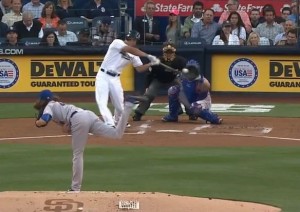
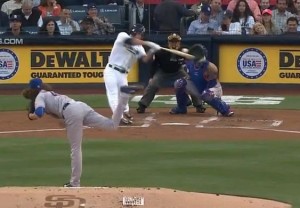
Not much later here was another deGrom strikeout:
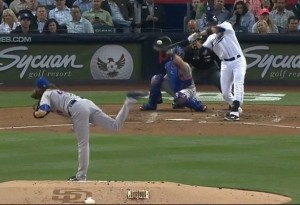
deGrom loves the fastball. He has the 14th-highest average velocity on his four-seamer among qualified starters, according to Baseball Prospectus. When deGrom has two strikes on a batter he goes to the fastball 47 percent of the time against lefties and 49 percent of the time against righties. With two strikes deGrom excels with the four-seamer (first chart is against righties, followed by lefties):
| Pitch Type | Count | AB | K | BB | HBP | 1B | 2B | 3B | HR | BAA | SLG | ISO | BABIP |
|---|---|---|---|---|---|---|---|---|---|---|---|---|---|
| Fourseam | 75 | 30 | 16 | 2 | 0 | 3 | 0 | 0 | 0 | .100 | .100 | .000 | .214 |
| Sinker | 21 | 8 | 3 | 0 | 0 | 1 | 0 | 0 | 0 | .125 | .125 | .000 | .200 |
| Change | 17 | 11 | 8 | 0 | 0 | 1 | 0 | 0 | 0 | .091 | .091 | .000 | .333 |
| Slider | 26 | 8 | 7 | 0 | 0 | 1 | 0 | 0 | 0 | .125 | .125 | .000 | 1.000 |
| Curve | 13 | 5 | 1 | 0 | 0 | 0 | 0 | 0 | 0 | .000 | .000 | .000 | .000 |
| Pitch Type | Count | AB | K | BB | HBP | 1B | 2B | 3B | HR | BAA | SLG | ISO | BABIP |
|---|---|---|---|---|---|---|---|---|---|---|---|---|---|
| Fourseam | 91 | 33 | 20 | 1 | 0 | 3 | 0 | 0 | 0 | .091 | .091 | .000 | .231 |
| Sinker | 25 | 14 | 5 | 0 | 0 | 4 | 0 | 0 | 0 | .286 | .286 | .000 | .444 |
| Change | 18 | 8 | 3 | 0 | 0 | 3 | 0 | 0 | 0 | .375 | .375 | .000 | .600 |
| Slider | 31 | 13 | 4 | 0 | 1 | 3 | 0 | 0 | 0 | .231 | .231 | .000 | .333 |
| Curve | 28 | 14 | 4 | 0 | 0 | 3 | 0 | 0 | 0 | .214 | .214 | .000 | .300 |
No extra-base hits allowed with two strikes, and when he goes to the fastball he has a 57 percent strikeout rate against all batters. OK, but what about the high fastball? Oh, it’s good. Here’s a strike zone plot of whiff per swing on his fastball with two strikes:
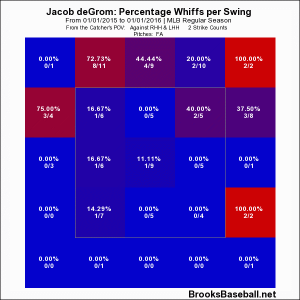
And since it’s so hard to make contact with his fastball high in the zone it’s insanely hard to get a hit against it:
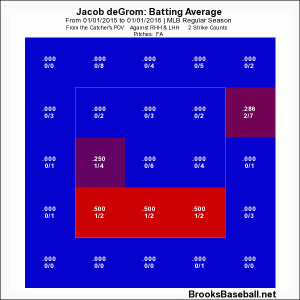
Hitters are 2-for-36 against a deGrom four-seamer in the upper two rows of that plot. I know average isn’t the best determinant of a player’s worth, but the isolated power plot is just a field of blue, seriously.
Something easier to read, courtesy of Baseball Savant:
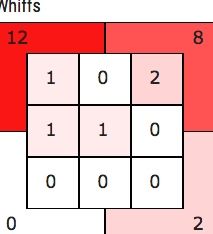
20 of deGrom’s 27 whiffs against all hitters have come high and out of the zone. deGrom has four really good pitches, as well as a sinker that generates ground balls at a 54 percent clip. But the fastball is the pitch he relies on the most, and it’s been a huge reason as to why he’s been as good if not better than his rookie performance in his sophomore season.
Most if not all statistics cited above are linked to their source, but this article couldn’t have happened without Brooks Baseball, Minor League Central, Baseball Savant, Baseball Prospectus and MLB.com.
Question? Comment? Catch me on Twitter @44amiller



